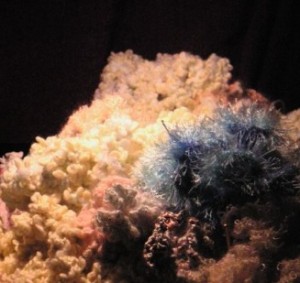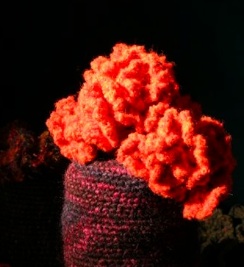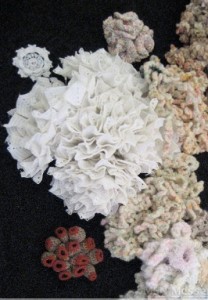Of Coral, Crochet, & the Hyperbolic Sublime
By:
April 17, 2009
MARGARET and CHRISTINE WERTHEIM are crocheting a coral reef, and they’re eager for help.

The sisters direct the Institute for Figuring in Los Angeles, which supports lectures, publications, and projects that explore the “figurative ecology” of nature and the human imagination. One nexus in that web of figuring is something topologists call hyperbolic space — the mathematics of enfolded and embedded surfaces. For millions of years, living forms have evolved iterations of hyperbolic space; its swoops and involutions are the signature of brain coral, kelp fronds, and the mantles of pelagic jellies. But to mathematicians, who long sought ways to model hyperbolic space, its complications seemed beyond reckoning.

The problem seemed insoluble — until Cornell mathematician Daina Taimima put the crafts she learned as a girl growing up in Latvia to use. Taimima used crochet to crack the hyperbolic code; her students now learn not only the methods of transformations in n-dimensions, but the algorithms of knit-one-pearl-two as well.
Inspired by Taimima’s whimsical and rigorous handiworks, the Wertheims found a way to combine artful science, women’s craft, and environmental activism. In 2005 they put out the call for crocheters to contribute to a crochet version of Australia’s Great Barrier Reef. The world’s largest structure made by living organisms, the Great Barrier Reef is visible from space. But climate change and pollution threaten it and coral ecosystems everywhere. With more than a thousand contributions to date, the Wertheims’ woolen reef is a tribute to the complex evolved beauty of life on Earth, and to the timeless genius of craftwork as well. Like its biological counterpart, the project continues to grow and change; the sisters and their collaborators are knitting with discarded plastic to illustrate to impact of trash on the oceans of the world.

The crochet reef debuted at the Andy Warhol Museum in 2007; since then, it has been exhibited across the country and on two continents, and soon it will go on display at the Smithsonian’s Natural History Museum (the first art project ever to be exhibited there). Perhaps the crochet reefs never will be visible from space. But there’s still room for them to grow — and the Wertheims still welcome contributors to the project. To read about it, and for many photographs of wondrous craftwork reefs, visit the Institute For Figuring.
UPDATE: Margaret Wertheim spoke about the Crochet Coral Reef at this year’s TED conference, and the video is now available:
Photos above from the following, from top to bottom: detail from Bleached Reef; Large Scale Anemone with Brain Coral Head; detail from The Bleached Reef, photo by Aaron and Cassandra Ott
